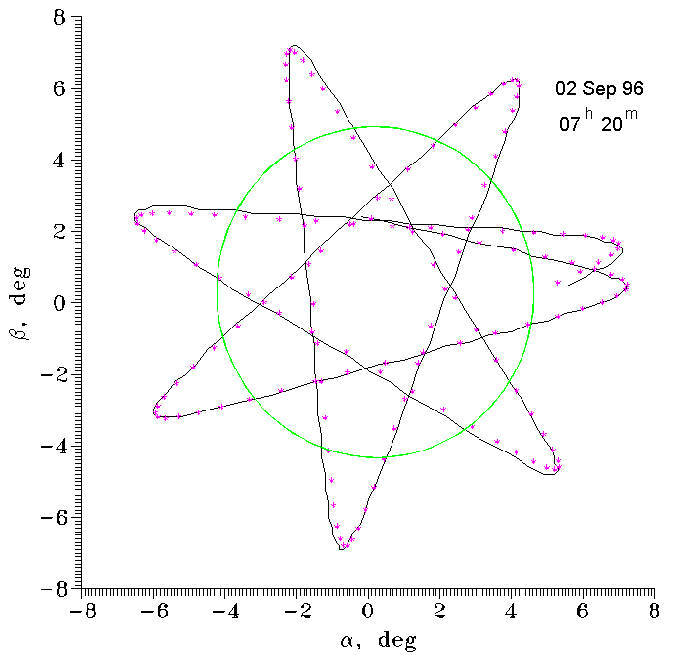
From: Natan Eismont and Elena Ryazanova
September 6,1996
Auroral Probe spacecraft is equipped by the same attitude control system as the Tail Probe. This system consists of solar sensors, angular velocity component sensors, onboard computer and cold gas jets. Its goal is to target the major inertia principal axis X towards the Sun and to spin up the s/c around this axis with a nominal spin rate 3 degrees/s.
Then the system is supposed to keep the angle between the X axis and direction towards the Sun inside 10 degrees margins.
The intervals between attitude control system operations is determined by the deviation of the direction towards the Sun due to the Earth orbital motion and deviation of the inertia axis due to the influence of external disturbance torques. For the Tail Probe these torques are proved to be negligible. For the Auroral Probe having apogee height 10 times as less as the Tail Probe the influence of the gravity gradient tonque is quite visible and can cause drift of the angular momentum vector up to 5 degrees per day. It was estimated by mathematical modelling of the attitude motion. In these calculations the s/c was supposed to be a solid body, inspite that it is not so actually.
The s/c is equipped by the very long booms (about 23m from tip to tip) which are flexible enough. In the absence of external moments their influence (if the s/c spin axis is the major principal axis) can only damp the nutation because the rotation around this axis is the minimum energy rotation.
So the mentioned drift of the angular momentum was expected with the principal axis practically coinciding with it, i.e. with the nutation amplitude being close to zero.
But the real life occured to be richer.
The results of solar sensors data processing are presented at the figure below.

the violet stars are the measurements, one tick corresponds to about 4 seconds;
the black line is approximation of the motion;
the green line is the angular momentum vector motion with respect to the s/c.
Alpha are the angle between the X axis of the s/c and projection of the Sun vector (violet and black) are angular momentum vector (green) onto XY plane, beta are is the same angles for XZ plane.
According to these results related to August 2, 1996, 4 hours 20 minutes ut (Moscow Decret time: 7 hours 20 minutes, one day after spin axis targeting to the Sun) the nutation amplitude was about 4 degrees and the angle momentum vector was about 2.6 degrees. Period of spin was 112 s, and angular momentum period was 151.3 s. It corresponds to the principal inertia momentum ratios.
Taking into account that initial nutation amplitude was less than one degree the results contradict those supposed before.
The reason of this phenomena may be the resonance energy pumping due to flexibility of the booms under influence of the gravity gradient torque.
But this hypothesis demands more precise checking.
 Back to the Interball Home Page
Back to the Interball Home Page